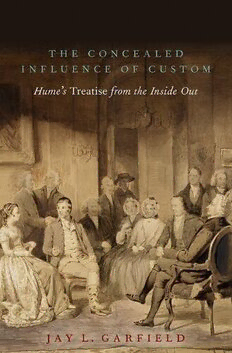
Concealed Influence of Custom: Hume's Treatise from the Inside Out PDF
Preview Concealed Influence of Custom: Hume's Treatise from the Inside Out
The Concealed Influence of Custom The Concealed Influence of Custom Hume’s Treatise from the Inside Out v v w Jay L. Garfield 1 1 Oxford University Press is a department of the University of Oxford. It furthers the University’s objective of excellence in research, scholarship, and education by publishing worldwide. Oxford is a registered trade mark of Oxford University Press in the UK and certain other countries. Published in the United States of America by Oxford University Press 198 Madison Avenue, New York, NY 10016, United States of America. © Oxford University Press 2019 All rights reserved. No part of this publication may be reproduced, stored in a retrieval system, or transmitted, in any form or by any means, without the prior permission in writing of Oxford University Press, or as expressly permitted by law, by license, or under terms agreed with the appropriate reproduction rights organization. Inquiries concerning reproduction outside the scope of the above should be sent to the Rights Department, Oxford University Press, at the address above. You must not circulate this work in any other form and you must impose this same condition on any acquirer. CIP data is on file at the Library of Congress ISBN 978– 0– 19– 093340– 1 1 3 5 7 9 8 6 4 2 Printed by Sheridan Books, Inc., United States of America To the memory of Annette C. Baier Who taught us how to read Hume Such is the influence of custom, that, where it is strongest, it not only covers our nat- ural ignorance, but even conceals itself, and seems not to take place, merely because it is found in the highest degree. (EHU 4.24; SBN 28–2 9) CONTENTS Preface ix PART I. Methodological Preliminaries 1. Introduction: Principles of Interpretation 3 2. Why the Treatise? Why Book II? Why Custom? 28 PART II. Book II: The Psychological Foundations 3. The Passions: Some Basic Distinctions 49 4. The Passions and Human Nature 71 5. Hume’s Moral Psychology 90 PART III. Books I and III: The Skeptical Framework Deployed 6. Epistemological Foundations 105 7. Causality 128 8. Skepticism with Regard to Reason 152 9. Of Skepticism with Regard to the Senses 172 10. Personal Identity and Philosophical Method 203 11. Ethics 225 PART IV. Living Carelessly 12. The Appendix: Second Thoughts about Second Thoughts 263 13. Persons as Customary Creatures 273 References 281 Index 289 ( vii ) PREFACE In 1972, the late Norman S. Care assigned me to read parts of the Treatise in my first philosophy class, in my first semester of college (a class I took by accident). After reading Hume’s discussion of personal identity, I declared a philosophy major. I am sure that I am not alone in having been lured into the study of philosophy by Hume. I have never stopped thinking about the Treatise, and this book is the distant effect of Norman Care’s teaching, but, like any effect, it has many causes and conditions. My interest in Hume was sustained as an undergraduate by an Oberlin colloquium on Hume. On that occasion, two eminent Hume scholars were extraordinarily generous and indulgent to a naive and probably overenthusiastic undergraduate. I still remember talking at length with Terence Penelhum about the structure of Hume’s ethics and the role of an ideal observer, and with Lewis White Beck about the degree to which Kant really diverged from Hume on causality. Neither of these giants of Hume scholarship had any obligation to talk to me, and I am very grateful that they indulged a novice philosopher. This is just one instance that demonstrates how important small acts of gener- osity to students can be, and just how much our lives depend upon chance and upon the kindness of others. I went from Oberlin to Pittsburgh, where I quickly fell under the spell of Annette Baier, who really taught me— and so many others— to read and to love Hume. Annette opened the Treatise as a systematic unity, and showed why it was so important to take Book II so seriously. I am always conscious of how much of my philosophical life I owe to her patient and inspiring teaching. The reading of Hume I offer here is enormously indebted to her own. Indeed, virtually every specific idea I advance derives in some way from her work. If there is anything I add here, it is simply to draw insights together that are scattered in her work, and to give a shape to them not explicit in her own corpus, but certainly suggested by it. So, to adopt the scholastic language appropriate to this philosophical genre, the present ( ix )
